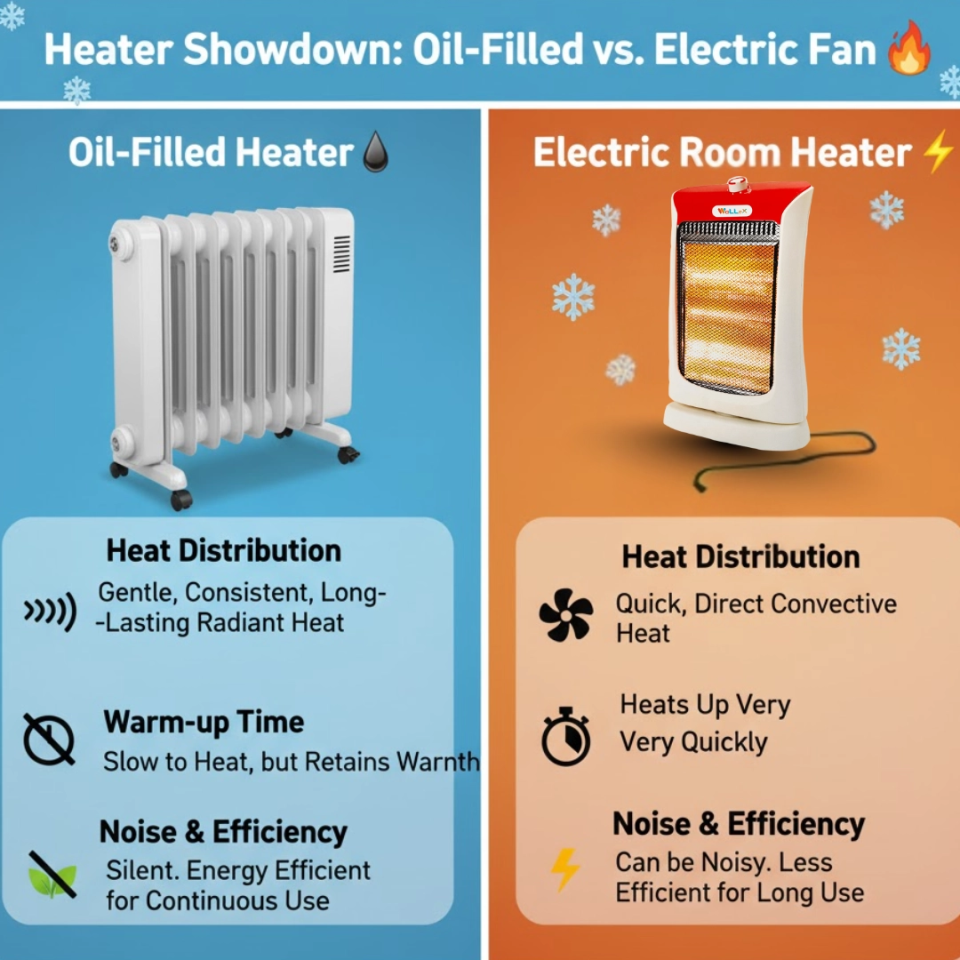
Now keeping your house warm is simpler than ever before due to the numerous options available in the market in terms of various modern systems of heating rooms. In both urban and semi-urban areas, people are now resorting to oil-filled and electric room heaters due to their efficiency, ease of use and rapid outcomes. Did you know? Recent studies on the use of home appliances in energy savings related to heating in rooms indicate that efficient room heaters which use less energy can reduce heating expenses by about 30 percent. In this article we will explore advantages and disadvantages of oil-filled and electric room heaters in order to make the most intelligent heating choice this season.
Oil radiators or oil-filled room heaters are based on a very basic principle. The oil specially designed to be used in these appliances is heated in metal columns within the appliances. The warm oil flows within the unit and spreads warmth all around your room in a soft consistent manner.
Internal Heating Element: The oil is heated by a coil within the appliance, and it is not burnt or lost, however, this is a closed system that does not burn or burn the oil; hence, the oil remains in the device for lifetime.
Natural Heat Circulation: The oil within the columns is heated and the outer part of the heater is warmed gradually.
Cold, even, quiet Warmth: Fire gives off the warmth through convection, and it fills your house without sound and without dust blown up.
Thermostatic Control: Built-in thermostats have the ability to regulate the temperature at all times, switching the heater on and off in an efficient way.
Unique Benefits
Silent: Operation: Virtually silent, having neither fans nor moving components, suitable for bedrooms and offices.
Retained Warmth: This is due to the fact that the heat of oil is high which keeps warm even after the device is turned off.
Low Humidity Effect: No burning of oxygen or drying of the ambient air and maintains the comfort and wellbeing of the indoors.
Read More: Types of Room Heaters
The oil filled room heaters are comfort, efficiency and peace-of-mind friendly. Take into account such outstanding features:
Greater Energy Saving: Most oil radiators are switched off after the required temperature is met, which allows saving on energy consumption and monthly payments.
Minimal Maintenance: There is no necessity to fill up or change the oil. Their closed design makes their cost of maintenance minimal.
Safe to Use: No Burns and fire risks, Open heating coils and flames covered.
No Oxygen Burn or Air Dryness: Unlike other traditional electric heaters, these ones do not reduce oxygen in the room or lead to a dry throat and skin
Thermal Inertia vs. Radiators: Oil filled heaters are highly thermally insulated by nature, which means that they store and release heat more continuously as compared to standard radiators, which results in an increase of long-term comfort and a reduction of energy spikes.
Oil filled heaters have numerous advantages, it is important to consider the possible disadvantages
Takes Longer to Warm: It also takes a while to experience the full warmth particularly in large areas as the heat is gradually accumulated.
Bulky and Heavier: They are heavy and carry oil, they are difficult to transport around rooms than the less heavy electric heaters.
Increased First Purchase Price: The overall price of the first purchase is higher because of the materials and technology are more durable.
Not suited to Quick Spot Heating: This will be most likely to work with long-term, background heating, but not instant heat in a new place.
Oil filled heaters, although more expensive and slower to start up, should be purchased by families that want reliable continuous and overnight warmth with less air disruption and noise and require these qualities in bedrooms, nurseries, and offices.

Read More: How to Use a Room Heater
There are many types of electric room heaters, with each type designed to meet particular requirements. They make use of a heating component; a common coil or ceramic plate to produce heat, which is distributed to the room through convection, radiant panels, or fans.
Convection Heaters: This uses a natural uprising of the warm air and gives the entire room even warmth- good in medium-sized rooms.
Fan Heaters: This is a mix of a metal coil or a ceramic element with an inbuilt fan to provide quick and direct warmth. Perfect where it is necessary to heat a small area or spot.
Radiant (Infrared) Heaters: Radiant heaters heat objects and individuals without heating the surrounding air reaching targeted areas providing instant comfort
Instant Heating: Fan models and radiant models provide quick heat- superior when you come in the cold and need some warmth.
Light and Portable: Small electric room heater can easily be transported everywhere warmth is required, and hence a convenient option to homes and small offices.
Inexpensive: They are relatively cheap when compared to the oil versions and can thus be used by people on a budget or infrequently.
Oscillation Feature: Most newer models have oscillating components to evenly balance heat to eliminate cold spots.
Noise: Fans may be heard and this may disturb other light sleepers or those who require maximum silence.
Cleaning: It has to be cleaned regularly because dust will be present in the fans and on heating elements.
Needs Constant Power: This is an immediate heat dissipation and it requires constant power to maintain a constant temperature.
Possible to Cause Air Dryness: Prolonged use and in small cramped rooms with inadequate ventilation could dry the air causing discomfort.
Less Regulated Room Heating: Could result in hot zones or unbalanced heating of large rooms.
Electric heaters are convenient and cost-effective in small rooms or those rooms with a rapid heating demand, like a study room, a bathroom, or a nook in the kitchen for overnight heating of bedrooms or all-day warmth, the oil-filled room heaters are still the best option in terms of saving on energy and long-term comfort.
The oil-filled and electric room heaters are invaluably useful during cold winters but they serve slightly different purposes. You may want to use an oil-filled room heater in case you need steady, noise free, and long-lasting heating - best when used in a bedroom and family gathering room. Select a room heater that is electric in nature and more importantly compact where rapid heat and portability are important, as well as where it is used sparingly and in small areas. With the development of smart home technology, be on the lookout of the new generation of heaters that include energy saving capabilities as well as environmentally friendly looks and adjustable heating systems that not only will provide comfort but also sustainability throughout the future seasons.
Ans: It uses electricity to heat a sealed reservoir of thermal oil. The heated oil circulates through metal columns, radiating warmth evenly into the room without burning the oil.
Ans: Oil-filled heaters are generally safe for overnight use because they have no exposed heating elements or flames and often include safety features like overheat protection and tip-over switches.
Ans: Electric room heaters can pose a fire risk if placed too close to flammable materials, left unattended, or used with damaged cords.
Ans: An oil-filled heater typically uses 1000 to 2500 watts per hour, depending on its size and setting. On average, running a 1500-watt heater for one hour consumes about 1.5 units (kWh) of electricity.